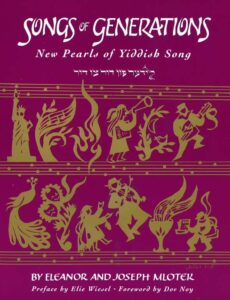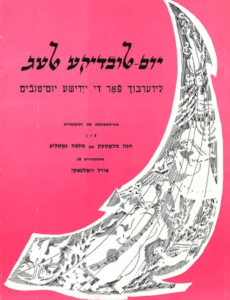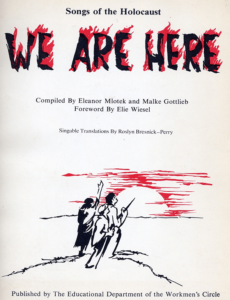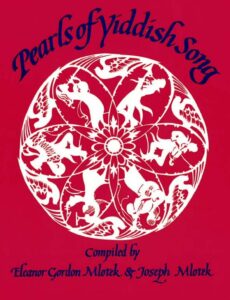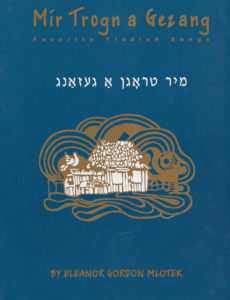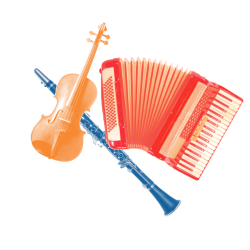Discover the Music
Browse through each song book or search the entire collection.
Search
Brontshele
Folksong. Variant text published by S. Ginzburg and P. Marek in 1901; text and music published by Platon Brounoff in 1911 and Y. L. Cahan in 1912. This version was published by Menakhem Kipnis in 1918. The song motif of the young man requesting permission to enter his lady love’s house was traced to the 16th century by folklorist Y. L. Cahan (see Cahan, Shtudyes). German and Czech parallels are cited by Cahan, 1912.
On the YIVO recording Folksongs in the East European Jewish Tradition, from the repertoire of Mariam Niremberg (1986), produced by Barbara Kirshenblatt-Gimblett, a drunken cardsharp is calling on Rifkele and threatens to poison himself if she won’t let him in: “Kh’hob moyre far dayn mamen. / Rifkele, efn mir / Anit vel ikh zikh farsamen.” In other songs of this type the girls’ names are variously Nekhamele, Brayndele, Khaye-Sorele, Shifkele, Rokhele.
S. Lehman published a variant in Arbet un Frayheyt, 1921, of a prisoner who says he will keep knocking on the iron door until he will be freed. Motl Zelmanowicz submitted a parody that was sung in the Jewish Labor Bund in Poland in the ’20s.Two parodies that were sung in the Lodz Ghetto were cited by Gila Flam. In one “Ver klapt do azoy shpet bay nakht? / Es klapt der geto hinger” (Who knocks so late at night? It is the Ghetto hunger), the plea is to “Open the provision store, it will make it easier.” The girl here fears “dem altn” (The Eldest of the Judenrat of the Ghetto Chaim Rumkowski).
Bulbes
A folk song (text and music published by S. Kisselgof in 1911) that jests about the poverty and mean fare of the Jews in the Old Country. The folklorist Meir Noy of Israel published in Yeda Am an interesting and unknown version of the song that was popular among the Jewish soldiers in the Austro-Hungarian Army during World War I. There are several stanzas in addition to the bulbes-refrain, one is: “Must one only eat meat and have a fat belly? In time of poverty potatoes are also a delicacy.”
Dayeynu
Dem Baal Shem Tovs Zemerl
Words by Moyshe Bassin (1898-1971); music by Yosl Rumshinsky (1881-1958). Published in sheet music by Metro Music Co., N.Y., 1954.
Dem Milners Trern
The Miller’s Tears by M.M. Warshawsky (see note to Oyfn Pripetshik on page 2) refers to the expulsion of Jews from their villages in Czarist Russia.
Dem Pedlers Brivele
Dem Zeydns Brokhe
Poem by Yosl Joffe (1865-1938) was published in 1901 in Der Yud. Words and music in the arrangement of H. Lefkowitch published in sheet music by Metro Music Co., N.Y., 1940. The song was a favorite in the repertoire of singer Sidor Belarsky.
Der Eybershter Iz Der Mekhutn
The allegorical song refers to the marriage between the Torah and the people of Israel which took place on Mount Sinai, with Moses officiating as matchmaker. It is folklorized from a poem “Der yikhes-shidekh” by Abraham Goldfaden (1840-1908) published in 1866. The words and music were published by S. Kisselgof in 1911. The song was in the repertory of singers. Sidor Belarsky and Mascha Benya Matz, who sang it together on the recording Amol iz geven a mayse, compiled and narrated by Yosl Mlotek.
Der Filosof
This humorous song (originally titled Dos Gute Kepl) by Velvl Zbarzher (1826(?)-1883) is a satire upon the alleged miracles performed by the Hassidic rabbis. The song was first heard during the Haskalah period in Eastern Europe, when satirizing fanatic beliefs was in vogue. Many singers today erroneously interpret this song literally, as one that expresses the wonders of the rabbis. The song was later parodied during the 1905 revolutionary period to “go to the working man and learn wisdom from him.”
Der Fodem
Text by Mark Markovich Warshawsky (1840-1907), author and composer of many Yiddish song favorites like “Oyfn pripetshik,” (At the fireplace), “Di mizinke oysgegebn” (The youngest daughter’s wedding) and others. Text and music published in Yidishe folkslider (Warsaw, 1917) and in an arrangement by Leo Low in sheet music by Jos. P. Katz, N.Y., 1917.
Der Hoyfzinger Fun Varshever Geto
Words are by Reuven Lifshutz (1918 – 1975), author of a collection of songs and poems that were written in the Warsaw ghetto and in a Displaced Persons camp in Munich. He survived the war and lived in Chicago. The melody is a popular street tune.
Der Kashtnboym
Words by Yitskhok Perlov (1911-1980); music by Lola Folman (1908-1979). The song was submitted by Hershl Altman, Bronx, N.Y. who heard Lola Folman sing it in the DP Camp Ziegenheim, Germany, in 1945. At that time, he writes, she was touring with her husband, Yitskhok Perlov, to bring comfort to the survivors. In this country the song was popularized by actress Mina Bern, who submitted the melody.
Der Kranker Shnayder
Words by playwright and ethnographer Sh. Ansky, pen name of S. Rapoport (1863-1920), author of the famous Yiddish play The Dybbuk. The melody published here has been sung by Nekhama Lipshutz, Ben Bonus and Emil Gorovets. It was transcribed from Gorovets’ recording.
Der Kremer
Part of a 25-stanza poem by Abraham Liessin (1872-1938); music attributed to Pinchas Jassinowsky. The original poem was written in Minsk in 1896. Words and music were printed in 1951 by S. Bugatch and Sidor Belarsky. The song was a favorite number in the latter’s repertoire.
Der Oytser
Words by Z. Telesin (1905-1996), music by Lev Kogan. The song was submitted by actress-singer Mina Bern.
Der Rebe Elimeylekh
A Yiddish version of the English song, Old King Cole. Poem and music by Moshe Nadir (1885 – 1943). One folklorized version was published anonymously by S. Bastomski in 1923. The text and music were published by M. Nadir in 1927, as well as in the author’s book A Lomp Oyfn Fentster in 1929.
The last stanza of the original text reads:
“Er hot geton a gutn genets / Un gezogt: me darf shoyn meyn nit! / Un geshikt di kapelye aheym. Di shikere kapelye fun Rebn Meylekh-Elye, / Hot oysgeshtelt dem dales a fayg. / Di freylekhe kapelye hot gehopket biz der stelye / Un zikh farbitn mit di klaper-getsayg. Di fidldike poyker hobn tsimbldik gefidlt, / Un bronfndik gegosn zikh mit vayn. / Di lustike klezmorim mit flesher untern orem, / Hobn gehulyet bizn heln tog arayn.” (He yawned, said it was enough, and sent his musicians home. The drunken band of Rabbi Meylekh-Elye danced and cavorted merrily, exchanging instruments. They caroused until dawn.)
Der Rebe Hot Geheysn Freylekh Zayn
Popular melody appearing in numerous collections as an anonymous folksong. The song is possibly derivative of the text presented here which was written by Avram Goldfaden (1848- 1908), founder of the modern Yiddish theatre, for his operetta Ni-be ni-me ni-kukeriku, staged in Jassy, Rumania in 1878; it appears in two operetta manuscripts in the Sholem Perlmutter collection at YIVO. In the catalogue of the Hebrew Publishing Company, Goldfaden is also cited as the composer of the song.
The words and music underwent many transformations and adaptations. Irving Berlin wove the melody into one of his first songs, “Yiddle on Your Fiddle, Play Some Ragtime,” published in 1909. The melody, entitled “Der rabi [sic] hot geheysn lustik zayn” appears in J. Fleischman’s 25 Hebrew Songs and Dances (1911). Part of the melody was used in the song “Yoshke, Yoshke, shpan dem loshek,” published in 1912 by Y. L. Cahan. Words and music were published in 1919 by Janot S. Roskin. The song’s title was used as the title of Isidore Lillian’s operetta, staged in 1921, for which Joseph Rumshinsky’s arranged the melody. The melody was also sung to Mark Warshafsky’s song about two sisters, Sore and Rifke, and Zanvel Zilberts arranged the melody for the song “Reb Dovidl fun vaslikove,” words by F. Fuchs (1924).
In 1952, a French wedding song “Tire l’aiguille” was published with this melody. It was also discovered in 1981 in the Hai and Topsy Frankl collection in Frankfurt as a Simkhas Torah song.
In a Soviet-Yiddish version, published in 1940 by I. Dobrushin and A. Yuditski, the stanza beginning with “Yoshke, Yoshke, shpan dem loshek” was changed to “Lomir, ale freylekh zayn, vayl mir veysn nit fun keyn payn” (Let us all rejoice, for we know no sorrow). The loshek — the horse — will be strong as iron and will fly like an eagle over the free earth, and enemies, like hares, will be driven from the fields.
Used by permission of the copyright owners, Ethnic Music Publishing Co., inc.
Der Yid Der Shmid
Words by Wolf Younin (1908-1984); music by Vladimir Heifetz (1893-1970). Published in sheet music by Metro Music Co., N.Y., 1952. An adaptation for children appears in Yosl Mlotek’s textbook Yidishe kinder-alef (Jewish Children-A), N.Y., 1971.
Der Yold Iz Mikh Mekane
Folklorized song of the underworld, published by S. Lehman in Warsaw (1928), who writes that the song arose during the German occupation in Poland during World War I. It also appeared in the VIVO Filologishe shriftn, V, 1938. According to the sheet music published in this country, the words are by Gus Goldstein, music by Max Leibowitz, published by S. Schenker Co., N.Y. in 1920. The song was submitted to the Perl by the following readers: Sam Adler, Studio City, Ca.; Godl Jacobson, Hallandale, Fla., Abraham Arbetman, LA., Hershl Altman, Bronx, NY., Jacob Schaefer, L.A., Kh. Tselemenski, Montreal, Victor Weitzman, North Miami Beach and Chaim Sheskin, Brooklyn, N.Y. It was sung by Lillian Klempner in the film Image Before My Eyes produced by Josh Waletzky.
Der Yunginker Shnayderl
Words by the Yiddish poet Mani Leib, pen name of Mani Leib Brahinsky (1883-1953); music by David Beigelman (1887-1944). Transcribed by compilers from a recording by a singer-actor Menashe Oppenheim.
Di Beryozkele
Words by David Einhorn (1886-1973); published by M. Kipnis in 1918. The song was popular in Poland in the 1930’s. It is a favorite in the repertoire of Soviet Yiddish singer Emil Gorovets.
Di Bord
Folklorized version of a song by Mikhl Gordon (1823-1890), author of such popular songs that are considered folk songs like Di Mashke, Di Shtifmuter, As Ikh Volt Gehat Dem Keysers Oytsres, Fun Der Khupe Tsu Der Stude, and others. Di Bord was originally published, like others, anonymously “fun a groysin khosid” in 1868 out of fear of the Hassidim. The author included with revisions in his second collection in 1889, under his real name. This song, written during the Haskalah period in Russia, pokes fun, through the personification of the beard, at the tragic reactions to changes in traditional practices and appearances. The folklorized version was collected and published by Chana Mlotek in 1951.
Di Dray Neytorins
Words by Y. L. Peretz (1852-1915); music by M. Shneyer (1885-1942). Published by M. Kipnis in 1918. The composer’s name was kindly furnished by musicologists lssachar Fater and Meir Noy, Tel Aviv.
Di Goldene Pave
Folk song. Text published by Ginzburg and Marek in 1901; text and music published by the St. Petersburg Society for Jewish Folk Music in 1909. The theme of the bitter and harsh treatment of a young bride by her in-laws is a popular one in the Yiddish folk song. The golden peacock became the poetic symbol of the Yiddish folk song, carrying messages and greetings from loved ones. The theme was adopted by such modern Yiddish poets as M.L. Halpern, Itsik Manger and others.
Di Grine Kuzine
This song (text by J. Leiserowitz, music, A. Schwartz) was one of the most popular songs of immigrant life in America. This version was published by Chana Mlotek in 1954.

